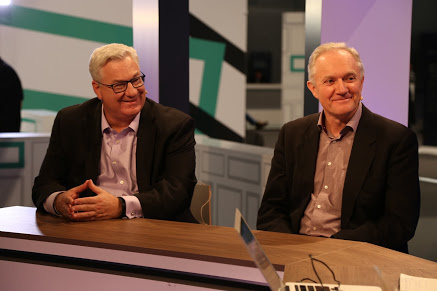 BIG DATA
BIG DATA
 BIG DATA
BIG DATA
 BIG DATA
BIG DATA
Nearly every enterprise has plenty of data to process, but a group of scientists in England may be facing the ultimate challenge. They are researchers with the Centre for Theoretical Cosmology, known as COSMOS, at the University of Cambridge, and their database is only 14 billion years of information gathered from the Universe.
“It’s a very data-driven science, and so we have to try and keep up with this flood of new data, which is getting larger and larger,” said Paul Shellard (pictured, right), director of COSMOS. “We’re kind of in a new age of exploration, and we’ve only got a tiny fraction of the Universe mapped so far.”
Shellard stopped by the set of theCUBE, SiliconANGLE Media’s mobile livestreaming studio, and spoke with co-hosts Dave Vellante (@dvellante) and Peter Burris (@plburris) during the HPE Discover EU event in Madrid, Spain. He was joined by Randy Meyer (pictured, left), vice president and general manager of mission-critical systems at Hewlett Packard Enterprise Co., and they discussed the challenges of managing huge data sets and how HPE’s new supercomputer is helping researchers. (* Disclosure below.)
COSMOS is famed theoretician Stephen Hawking’s institute and also a customer of HPE. The institute’s scientific researchers are using HPE’s new Superdome Flex, a computer that can store up to 40 terabytes of data in high-speed memory. This allows data crunching, in this case 14 billion years of data, to be processed much more quickly than with a standard storage system.
“There’s a whole different side to what you can do with in-memory compute, and it’s all in this high-performance computing space,” Meyer said. “This is the world’s largest pattern recognition problem.”
The HPE supercomputer has freed COSMOS scientists to focus on the weightier problems of gravitational waves and black holes, rather than get bogged down in software development and bug-fixing. “You don’t have to be an advanced programmer to get going,” Shellard explained. “You can more or less develop your pipeline on a laptop, take it to the Superdome, and then scale it up to these huge memory problems.”
Watch the complete video interview below, and be sure to check out more of SiliconANGLE’s and theCUBE’s coverage of the HPE Discover EU event. (* Disclosure: TheCUBE is a paid media partner for the HPE Discover EU event. Neither Hewlett Packard Enterprise Co., the event sponsor, nor other sponsors have editorial control over content on theCUBE or SiliconANGLE.)
THANK YOU